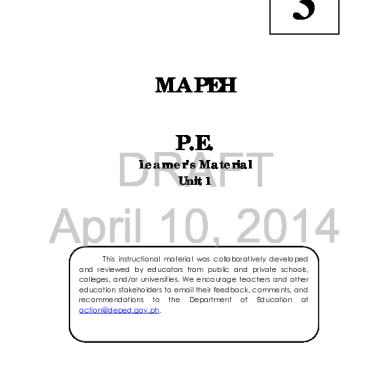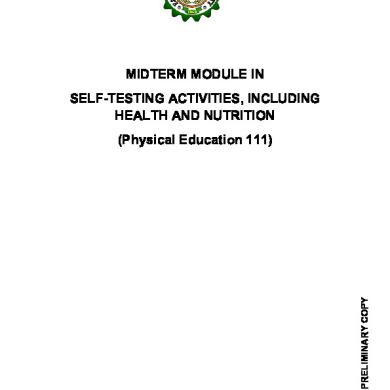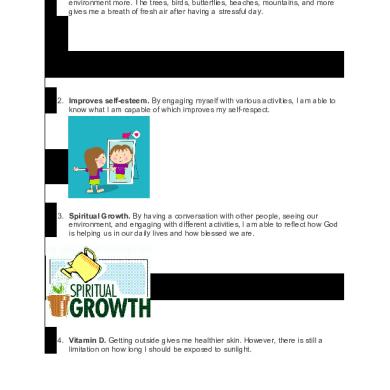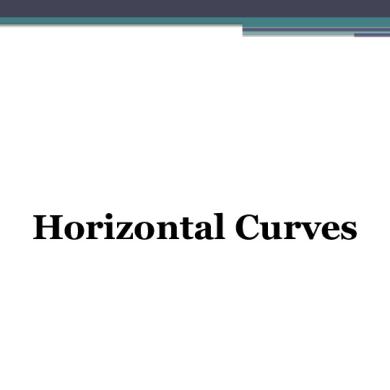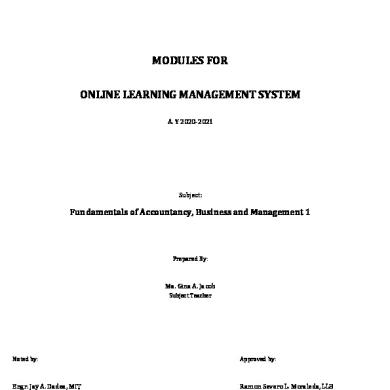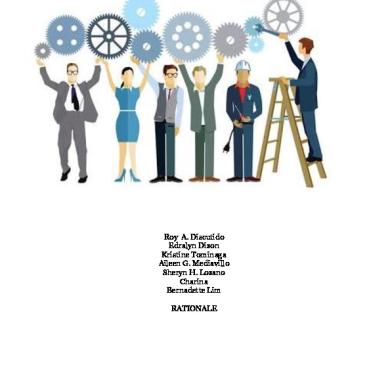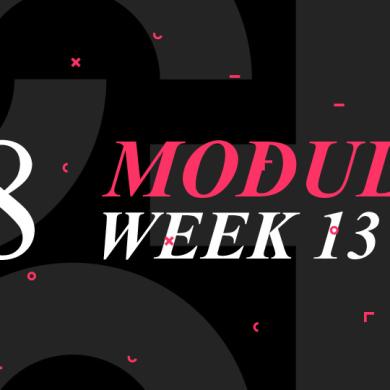10 Physical Education
10 Physical Education Quarter 1 – Module 2: Yoga as Recreational Activity
Physical Education- Grade 10 Alternative Delivery Mode Quarter 1 – Module 2: Yoga as Recreational Activity First Edition, 2020 Republic Act 8293, section 176 states that: No copyright shall subsist in any work of the Government of the Philippines. However, prior approval of the government agency or office wherein the work is created shall be necessary for exploitation of such work for profit. Such agency or office may, among other things, impose as a condition the payment of royalties. Borrowed materials (i.e., songs, stories, poems, pictures, photos, brand names, trademarks, etc.) included in this module are owned by their respective copyright holders. Every effort has been exerted to locate and seek permission to use these materials from their respective copyright owners. The publisher and authors do not represent nor claim ownership over them. Published by the Department of Education Secretary: Leonor Magtolis Briones Undersecretary: Diosdado M. San Antonio Development Team of the Module Author: Editors:
Reviewers:
Lucky Nestor A. De San Juan Gene A. Reginaldo,
Edwin C. Padasdao
Ritchelle B. Dejolde Editha T. Giron
Antonio V. Laceste, JR
Gina A. Amoyen
Evangeline A. Cabacungan
Francis A. Domingo
Jenetrix T. Tumaneng
Layout Artist/
Rodel R. Rimando
Illustrator:
Lucky Nestor A. De San Juan
Management
Tolentino G. Aquino
Joan A. Corpuz
Arlene A. Niro,
Mariecon G. Ramirez
Gina A. Amoyen
Arnel S. Bandiola
Editha T. Giron
Arthur M. Llaguno
Francis A. Agbayani
Gene A. Reginaldo
Team:
Printed in the Philippines by:_____________________________________________ Department of Education Office Address: Flores St. Catbangan, City of San Fernando, La Union Telefax: (072) 607- 8137/ 682-2324 E-mail Address:
[email protected]
What I Need to Know This module was specifically developed and designed to provide you fun and meaningful learning experience, with your own time and pace. The module is divided into four lessons, namely: • • • •
Lesson Lesson Lesson Lesson
1 2 3 4
– – – –
Introduction to Yoga Yoga Exercise Development of Yoga Making it Part of Life
After going through this module, you are expected to: • • •
assess physical activity, exercise and eating habits; PE10PF-Ia-h-39 engage in moderate to vigorous physical activities for at least 60 minutes a day in and out of school PE10PF-Ib-h-45; and express a sense of purpose and belongingness by participating in physical-related community services and programs PE10PF-Ib-h-48.
1
Lesson
1
Introduction to Yoga
Hello there, welcome back! Today’s lesson is all about yoga. Sounds familiar? Let’s get to know more about it.
What I Know Directions: List down your observations about the picture below in your activity notebook. Be guided with the following questions: 1. What is the model doing in the picture? 2. What do you call the position of the model? 3. Have you tried doing it or have you seen one?
__________________________________________________________________________________ __________________________________________________________________________________ __________________________________________________________________________________ __________________________________________________________________________________
2
What’s In
Directions: Answer the following questions in your activity notebook. 1. What is meant by FITT? 2. How was your experience doing your planned strength exercise? 3. Are you on track in terms of your fitness target?
What’s New Direction: X-TERMINATOR- Eliminate all the letter X to reveal the hidden words in the table. Use your activity notebook for your answers.
K X A X I X X X V X
U X S X Y X B X I X
N X H X E X I H N X
D X T X N X K A Y X
A X A X G X R T A X
L X N X A X A H S X
I X G X R X M A A X
N X A X X X X X X X
Are you familiar with those words? Let us now proceed to the next page to deepen your knowledge about yoga.
3
I X X X X X X X X X
What is It A. What Yoga is Yoga is an activity that originated in India. It is derived from the word yuj, which means “to add,” “to join,” or “to attach.” It is an ancient form of exercise that builds the strength and flexibility of a person. It is also considered as a therapy that boosts physical and mental well-being. The main components of yoga are posture and breathing. Yoga helps in controlling an individual’s mind, body and soul. It brings together physical and mental disciplines to achieve a peaceful body and mind; helps manage stress and anxiety; and keeps you relaxed. It also helps in increasing flexibility, muscle strength and body tone. It improves respiration, energy and vitality. Practicing yoga might seem like just stretching, but it can do much more for your body from the way you feel, look and move. Regular practice of yoga can help lose weight, relieve stress, improve immunity and maintain a healthier lifestyle.
In every activity that we engage in, we need to consider our safety. Even if we do not move a lot in yoga, we still need to follow precautionary measures or etiquette. Adapted from Eva Norlyk Smith, Ph.D
B. Precautionary Measures
1. Have a beginner’s mindset. Yoga may look comparatively simpler, but it’s not. Start with a series of yoga classes for beginners which will introduce you to the basics in a systematic way. 2. Listen to your body. Listening to your body and honoring its signals is key to a safe practice. If you feel something like strain, you're pushing too hard. If your body feels like it needs a break, then relax and position yourself in child's pose. 3. Do your own pose, do not copy your neighbor. 4
For most of us, the mind tends to overrule the body. There are appropriate poses for others that we cannot execute. So do not copy something beyond your capability, not until you’re ready for it. Therefore, honor what your body could execute. 4. Look for your good edge. Look for the sweet spot in every pose. That is where you are challenging the body and yourself but still staying completely within your comfort zone. Appreciate your achievement. 5. Choose the right teacher and approach. Yoga teachers vary in approach, style, experience and training. If you're young and fit, you will be able to handle a wide range of yoga styles and classes. Let your teacher know before the class, and don't be shy to ask if the lessons are suitable for you. If the teacher isn't able to offer specific feedback related to your condition, that's a good indication that the teacher might not be good for you.
C. Food Requirements What To Eat Before Yoga Session Those who are looking to practice yoga in the morning, it is better to eat bananas and other fruits like berries, at least 45 minutes prior to your session. Start your day with protein-rich foods like yogurt and dried fruits, oatmeal, fruit smoothies, eggs, homemade protein bars and protein shakes to kick-start your morning filled with energy. What To Eat After Yoga Session You should drink water 30 minutes after you have meditated. The idea is to regain the electrolytes that you may have lost during yoga which can cause cramps in the body. Eat a super nutritious meal after your yoga session. Indulge in a bowlful of fresh seasonal fruits or vegetable salads. You can also have hard-boiled eggs, a light sandwich, yogurt with nuts and seeds and cereals. What You Shouldn't Eat Before and After Yoga Don't eat a large meal prior to yoga class or avoid dishes that are rich in oil, spices and fried items. Fatty food slows down digestion.You shouldn't have foods that are rich in fat content that substantially slow down your digestion. Whether you are practicing yoga in the morning or evening, ensure that you are well-hydrated, even if it means drinking water, coconut water or lemon water. Your ability to move and maintain focus is compromised with even mild dehydration.
D. Introduction to Yoga 5
The body in yoga is the vehicle for the development of wisdom, and of spiritual awakening. As such, the body is treated to be sacred. The mastery of our body is considered the foundation of spiritual progress. In yoga we learn to discipline the body by developing awareness and attentiveness, tuning in to our body’s subtle energy flows and the life-giving rhythm of our breathing. The idea is that by becoming more deeply and subtly connected to our physical experience, we can become one or united with ourselves, more grounded, and less swayed by anxieties or neurotic cravings for things that will not truly satisfy us. This can be a very positive influence on our approach to life, offering an antidote to the usual noisy frantic pace that characterizes our modern world. Here are other benefits of yoga: • • • • • • • •
Attainment of perfect balance and harmony Self- healing. Removal of negative blocks from the mind and toxins from the body Augmentation of personal power Greater awareness Focus and concentration, especially important for children Decreased stress and tension in the physical body by activating the parasympathetic nervous system Better relationships
The variations of physical activities, breathing techniques, and relaxation in yoga connect the body and the mind. Types of Yoga
Goal
Hatha
To improve flexibility and balance
Vinyasa
To attain good strength, flexibility, and balance
Iyengar
To reinforce the muscles and support the joints
Bikram
To form Flexibility
Benefits
Target Population
Relaxing and restorative
Beginners
Weight reduction
Obese and weightconscious; also suited for runners and athletes
Emphasizes proper alignment
Relieves back and neck pain
Musculoskeletal problems
A style of hot yoga that increases the muscles’
Enhances athleticism
Athletes, also suited for amateurs
Description Combines poses with breathing techniques Also known as power yoga; fastpaced style that requires continuous movement
6
Kundalini
To calm the mind and energize the body
Ashianga
To develop strength and endurance
ability to stretch Done by doing body movements, chanting of mantras, and breathing Physically challenging style that consists of various poses
Tranquility and serenity within self
Individuals aiming for spiritual experience
Cleansing the body
Yoga practitioners
What’s More Activity 1: Read the following and answer the questions below. The Beginner Yoga Stages Stage One - Learn the Yoga Basics: The beginner student fundamentally needs to be equipped with yoga principles, such as how to do the most basic yoga poses that are a part of almost all classes, including sitting cross-legged (sukhasana), sitting with legs straight (dandasana), sitting on your heels (virasana) and doing a flow called sun salutations (nurya namaskar). Stage Two - Learn the Yoga Fundamentals, Core Stability: You must know how to properly activate your core (bandhas) and how to integrate your breathing (pranayama). Stage Three - Learn the Yoga Fundamentals, Strength and Stretch: Help you understand how to strengthen your core and maintain core stability while stretching and doing yoga. Stage Four - Learn the Yoga Fundamentals, Take the Next Step: Challenge yourself with more demanding poses and sequences.
Answer the following questions: 1. What is the importance of being knowledgeable about the stages of yoga? 2. How is it beneficial to you as a learner? 3. What are the possible consequences if we skip one stage in learning yoga? 7
Activity 2. Directions: Using the template below, think of a pose that is applicable to each stage. Write your answers in the activity notebook by giving a description of each pose.
Stages
Poses
First Stage
Second Stage
Third Stage
Fourth Stage
8
Lesson
2
Yoga Exercises
Welcome back to your second lesson. I hope you are wearing your jogging pants because we will be dealing with a lot of yoga exercises today!
What’s In Directions: Complete the following statements below by applying your knowledge and understanding on the stages of yoga and its safety measures. Use your activity notebook to write your answers. 1. As a beginner my knowledge in the four stages of yoga is ___________________________________________________________________________ ___________________________________________________________________________ 2. To perform yoga, I need to ___________________________________________________________________________ ___________________________________________________________________________ 3. For me, yoga is ___________________________________________________________________________ ___________________________________________________________________________
9
What’s New Directions: Perform the warm-up part of your strengthening exercise routine created in the previous module and record your pulse rate. Write your experience on this activity in your notebook. Pulse Rate
Reflection
What’s In
In the last lesson, Yoga was introduced to you. Today, you will be learning the different yoga postures. Yoga Postures Yoga Posture
Description
Mountain pose Tadasana
Hands are raised overhead, palms facing each other with arms straight (Figure of 11) and hold position for 1 minute.
10
Pose
Downward dog Adho (Mukha) Svanasana
Warrior (3rd type) Virabhadrasana
Tree pose Vrksasana
Body looks like an inverted “V” and the position is held for 3 seconds or 3 full breaths.
Right knee is bent at 90-degree angle, left leg is bent to a 45degree angle, arms are extended to the sides with palms facing down, and held for 1 minute
Sole of the right foot is positioned on the left thigh, hands are in prayer position, and stay for 30 seconds
11
Bridge pose Setu Bandha Sarvangasana
Start from supine lying position by lying on the floor with knees bent, thighs lifted until parallel to the floor, arms rested on the sides with palms down, chest is raised closer to the chin, and held for 1 minute.
Triangle pose UtthitaTrikonas ana
Arms are extended to the sides, bend over the right leg, let the right hand touch the floor while the left hand is extended towards the ceiling. Hold the position for 5 breaths.
The flexed left thigh is positioned over the stretched right leg. Let Seated twist the right elbow touch the left (1 type) AndhaMatsyendr knee, then twist to the left as far asana as you can, and stay that way for 1 minute.
Cobra Bhujangasana
Pigeon pose kapotasana
From supine lying position, press the shoulders down and slowly raise the upper body. Stretch and feel the tension from the lower back to the neck. Keep the position for 15-30 seconds.
From push-up position, the left leg is brought down while the right knee is bent on the floor, chest is brought closer to the floor 12
as the arms are extended in front. Hold for 30 seconds or longer.
Child’s pose Balasana
Sit on your heels, lower your chest and bend forward with chest closer to the knees. Let your forehead rest on the flat surface, with arms extended forward. Hold the pose, and breathe.
What’s More Activity 1: Let’s Try It Directions: Perform all yoga positions. Determine which ones are easy and which ones are challenging. Write your experience in your activity notebook. Activity 2: Family Bonding with Yoga Directions: Invite a family member to perform the different yoga positions with you. Each position shall be done in 18 counts. Ask them to share how they feel towards this activity.
Activity 3: Time to Create Directions: Choose 5 yoga positions that you wish to try. Write them in your activity notebook. Memorize the positions and perform them without looking at the illustrations.
13
Assessment
Directions: Write the yoga postures in the table below then execute them. Check the positions that you were able to execute and cross mark if you were not able to execute. Provide a reflection on each position. Yoga Posture
(/) or (x)
Reflection/Experience/
Additional Activities Directions: Perform at least five (5) different Yoga positions every day. List the positions using the template below. Write a daily journal about your yoga performance. Follow the following questions: 1. How do you feel every time you do yoga? 2. Can you feel any development in your body and concentration? Day 1
Day 2
Day 3
14
Day 4
Day 5
Lesson
3
Development of Yoga
Hi, so how do you find yoga? Let us explore more. Are you ready? Let’s proceed.
What’s In Directions: Matching Type. Match the yoga position in column A with its correct name in column B. Write your answers in your activity notebook Column A
Column B
1. A. Cobra 2. B. Seated Twist 3. C. Triangle Pose 4. D. Bridge Pose 5. E. Tree Pose
F. Lunge Position
15
What’s New Directions: Perform your choreographed routine with music of your choice. Record your performance in Yoga (Activity 3, Lesson 6) in your cellphone.
What’s More Activity 4. Time to Teach Directions: Ask your family member to perform the Yoga positions you chose. Execute them with the tune of a mellow music. Below is the rubric to be used. Criteria Execution 50% Attainability 30% Mastery 20% Total- 100 %
All the exercises were executed properly and with ease. The principle of FITT was observed and attained in the activity. All exercises were executed with mastery and in proper order.
Conduct a simple interview with your family members and let them share what they felt after the performance and how yoga could be beneficial to them. Activity 5: Directions: Create a simple fitness plan for Yoga applying the FITT principle. Yoga Posture
Mountain pose Tadasana
1st Week
2nd Week
F-3x a week I- Heel Raise T-45 sec. T-Hang in monkey bars (if available)
16
3rd Week
Downward dog Adho (Mukha) Svanasana Warrior (3rd type) Virabhadrasana Tree pose Vrksasana Bridge pose Setu Bandha Sarvangasana Triangle pose UtthitaTrikonasa na Seated twist (1 type) AndhaMatsyendra sana
Cobra Bhujangasana Pigeon pose kapotasana Childs pose Balasana
Congratulations, you have been doing great! I hope you were able to appreciate yoga.
17
Lesson
4
Making it Part of Life
Nothing can be greater than making good things become part of our life.
•
Yoga is very useful in worldly life to make the body healthy. With a healthy body, one is better able to undertake spiritual practice such as service towards the Absolute Truth (satsēvā).
•
If yoga is complemented with other forms of spiritual practice to purify the mental body and other bodies, then a person can achieve rapid spiritual progress in his lifetime. Thus, a person can make progress to achieve the purpose of life which is to unite with God.
18
What’s In
Directions: From a scale of 1-10 (1 being the most challenging and 10 being the easiest), rank the following yoga positions from the easiest to the most challenging ones to perform. Write the answers in your activity notebook. Yoga Posture
Reflection
Mountain pose Tadasana Downward dog Adho (Mukha) Svanasana Warrior (3rd type) Virabhadrasana Tree pose Vrksasana Bridge pose Setu Bandha Sarvangasana Triangle pose UtthitaTrikonas ana Seated twist (1 type) AndhaMatsyen drasana Cobra Bhujangasana Pigeon pose kapotasana Childs pose Balasana 19
What I Have Learned
Directions: Below is an exit ticket. After engaging in yoga exercises, complete the table below.
YOGA 3 things I like about yoga
2 things I want to share to my friends
1.
1.
2.
2.
1 thing I want to explore more
1.
3.
What I Can Do Directions: Write an essay using the following guide questions:
In what way can yoga help in improving one’s mental condition? How can yoga help in dealing with the current health crisis we are facing today?
20
Assessment Directions: Read the following questions and write the letter that best represents your answer in your activity notebook. 1. What ancient form of exercise builds the strength and flexibility of a person? A. Yoga B. Tai Chi C. Taekwondo D. Karate 2. What country pioneered Yoga? A. Philippines B. India
C. Venezuela
D. Brazil
3. Which of the following is true about Yoga? A. Yoga was introduced by Brazil. B. Yoga is intended for athletes only. C. Yoga is an alternative sports for gymnastics. D. It is considered as a form of alternative medicine that boosts physical and mental well-being. 4. Which of the following statements is not correct about Yoga? A. Promotes self- healing. C. Enhances personal power. B. Yoga is a difficult exercise D. Yoga is for living with greater awareness. 5. What type of yoga is used to develop flexibility and balance? A. Hatha B. Vinyasa C. Iyengar D. Bikram 6. What type of yoga is used to establish strength, flexibility and balance? A. Hatha B. Vinyasa C. Iyengar D. Bikram 7. What is the other name for Child’s Pose? A. Balasama C. Vrksasana B. Kapotasana D. Adho Svanasana 8. What yoga position requires the body to look like an inverted “V” and held on for 3 full breaths? A. Balasama C. Vrksasana B. Kapotasana D. Adho Svanasana 9. What yoga position requires the body to sit with your heels, chest lowered and moved forward closer to the knees, forehead to rest on the flat surface, with arms extended forward, and the pose held to breathe? A. Balasama C. Vrksasana B. Kapotasana D. Adho Svanasana
21
10. What yoga position is also known as Tree pose? A. Balasama C. Vrksasana B. Kapotasana D. Adho Svanasana II- Directions: Determine the proper sequence of the procedures to arrive at a certain yoga position. 1. Warrior I- Right knee is bent at 90-degree angle II- left leg is bent to a 45-degree angle III- arms are extended to the sides with palms facing down IV-and held for 1 minute A. I-II-III-IV
B. IV-III-II-I
C. I-III-II-IV
D. IV-II-I-III
2. Cobra I- From supine lying position, press the shoulders down and II- slowly raise the upper body III- Stretch and feel the tension from the lower back to the neck IV- Keep the position for 15-30 seconds. A. I-II-III-IV
B. IV-III-II-I
C. I-III-II-IV
D. IV-II-I-III
3. Pigeon Pose I- From push-up position, the left leg is brought down while the right knee is bent on the floor II- Chest is brought closer to the floor as the arms are extended in front III- Hold for 30 seconds or longer. A. I-II-III
B. III-I-II
C. II-I-III
D. I-III-II
4. Child’s Pose I- Sit on your heels, lower your chest and bend forward with chest closer to the knees. II- Hold the pose, and breathe. III- Let your forehead rest on the flat surface, with arms extended forward. A. I-III-II
B. I-III-II
C. III-II-I
5. Triangle’s Pose I-Arms are extended to the sides, bend over the right leg II-Hold the position for 5 breaths.
22
D. I-II-III
III- let the right hand touch the floor while the left hand is extended towards the ceiling. A. I-III-II
B. I-III-II
C. III-II-I
D. I-II-III
Reminder: Yoga is considered as an alternative medicine because of its healthy benefits physically, mentally, emotionally and spiritually. It keeps the body in good posture and helps in blood circulation because of the varied breathing techniques it offers. Considering the appropriate type of yoga to be performed is very important to prevent injuries.
Congratulations for a job well done. Your module ends here. Keep safe!
23
Lesson 7- What’s In
1. 2. 3. 4. 5.
A B C D E
24
Lesson 2
Lesson I
What I know- DO not Record
What I can do and Additional ActivityIt is the discretion of the teacher as to how many points shall be given to the learner based from the given response/s
Assessment
1. 2. 3. 4. 5. 6. 7. 8. 9.
Lesson II Whats In1. Hatha
A B D B D B A D A
2. Vinyasa 3. Iyengar 4. Bikram
10.C
What I know, What’s New, What I have Learned and What I can do- It is the discretion of the teacher as to how many points shall be given to the learner based from the given response/s
Lesson I-Whats IN 1. A 2. C 3. E 4. B 5. D Assessment
4.D
1. Refer to table of Types of Yoga
3. D
What I have Learned
2. D
6. Ashtanga
1. D
5. Kundalini
5. D
6.A 7. C 8. C 9. B
11. A 12 A 13 A 14 A
10. D 15 A
2. Refer to the table (Positions of yoga)
Answer Key
References: Bercando, MAV, Depiedra, ST, Espiritu AP, GIneta, JJD. (2015) MAPEH 10. 1373 E.Rodriguez, Sr. Ave., Kristong Hari, Quezon City, PH. St. Bernadette Publishing House Corporation. Callo, LF, Dajime, PF. (2016). Physical Education and Health Volume I. 856 Nicanor Reyes Sr. ST, Sampaloc Manila. PH. Rex Printing Company, Inc. Gonzalvo, RP, Melindo, NC, Punzalan, MD. Physical Education and Health for Senior High School. Rm. 108, ICP Bldg., Recoletos St., Intramuros, Manila. PH. Mindshapers Co., INC. Angeles PJR, Boquiren, L., Grecia, JG., Rosenberger, LG., (2017) LIVING WITH MAPEH. 1253 Gregorio Araneta Avenue, Quezon City, PH. Vibal Group INc. Concha, A.A, Ganzon, L.C, Fulgencio, MGA, Tungala, J.S. (2017) MAPEH 10. Phoenix Building, 927 Quezon Ave., Quezon City, PH. 375-1640/ 410-7635. Fax No.: 410-9330. Service @phoenix.com.ph INTERNET https://www.huffpost.com/entry/yoga-health_b_1191479 https://food.ndtv.com/health/international-yoga-day-2018-foods-to-eatbefore-and-after-your-yoga-session-this-yoga-day1870451#:~:text=Start%20your%20day%20with%20protein,hour%20before %20beginning%20to%20exercise. https://www.spiritualresearchfoundation.org/spiritual-practice/spiritualgrowth/yoga-pranayam-benefits-andimportance/?gclid=CjwKCAjwlZf3BRABEiwA8Q0qq8DPhzqJ4uQxY8sHVRp0j qkmaJkKaaK-B5s7QrSvLPMq60O3rWU22hoCSzgQAvD_BwE
25
For inquiries or feedback, please write or call: Department of Education - Bureau of Learning Resources (DepEd-BLR) Ground Floor, Bonifacio Bldg., DepEd Complex Meralco Avenue, Pasig City, Philippines 1600 Telefax: (632) 8634-1072; 8634-1054; 8631-4985 Email Address:
[email protected] *
[email protected] 26




